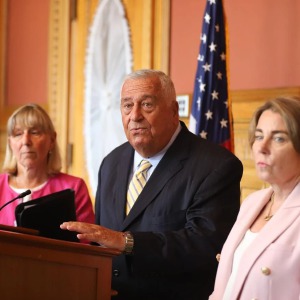Battery energy storage facility proposed for Erving’s Poplar Mountain

The Erving Conservation Commission met with energy company Spearmint Energy for a public hearing on Tuesday regarding a proposed battery energy storage facility on Poplar Mountain that would connect to the Eversource-owned substation. STAFF PHOTO/ERIN-LEIGH HOFFMAN
| Published: 07-02-2025 6:10 PM |
ERVING — Town officials and residents got a first look this week at preliminary plans for a battery energy storage facility being proposed by Spearmint Energy.
The 100-megawatt, 9-acre battery storage facility would be located on Poplar Mountain and would connect to Eversource’s Erving substation. The facility is called Rose Brook Battery Energy Storage due to its location off Rose Lane.
An informational handout from Spearmint Energy that was distributed at Tuesday’s Conservation Commission meeting explains the facility would store energy for future use by connecting to a charging source, such as a substation. The facility would help stabilize the energy grid, improve electric reliability and provide tax revenue.
Spearmint Energy Project Developer Ximena Lugo, Spearmint Energy Environmental and Permitting Consultant Justin Bailey and Fire & Risk Alliance Consultant James Caulfield joined Erving officials, residents and others at the meeting to outline the project’s status.
At a previous meeting in September, Granite Source Power’s Director of Development Donald Sheehan shared a map of the proposed site, information on wetlands delineation, and a design and grading plan for the storage system location.
Sheehan is working with Spearmint Energy for the wetlands delineation work, Lugo said, and a number of third-party contractors will do various environmental studies. The presenters stressed that this project is still in the early stages, which include site studies and public hearings before the Conservation Commission and Planning Board. Spearmint Energy hopes to have the facility operational by 2029.
“We essentially targeted [the Erving substation] because there’s capacity there for the company. Ideally, these [battery energy storage systems] want to be located either adjacent to the substation or along the transmission line,” Lugo explained regarding why the company has found Erving to be favorable host for a battery energy storage facility.
When asked about the next step in the permitting process, Bailey said the hope is to have the wetlands delineation presentable, allowing the company to submit an Abbreviated Notice of Resource Area Delineation, within the next month. The developers will also need to submit a special permit application to the Planning Board, which is intended to be done by the end of this year.
Article continues after...
Yesterday's Most Read Articles
 17-year-old Hatfield resident killed in Deerfield crash
17-year-old Hatfield resident killed in Deerfield crash
 80th Invitational Four Ball: Cody Booska and Chris Bourbeau take down Dave Kennedy and Nate Burdick to capture championship at Country Club of Greenfield.
80th Invitational Four Ball: Cody Booska and Chris Bourbeau take down Dave Kennedy and Nate Burdick to capture championship at Country Club of Greenfield.
 Several area departments put out Northfield house fire
Several area departments put out Northfield house fire
 Erving man, 60, found dead in Montague Plains Wildlife Management Area identified
Erving man, 60, found dead in Montague Plains Wildlife Management Area identified
 New role focused on downtown development in Northfield, Turners Falls and Shelburne Falls
New role focused on downtown development in Northfield, Turners Falls and Shelburne Falls
 Shutesbury begins police chief search
Shutesbury begins police chief search
Caulfield explained he’s been working with Erving Fire Chief Philip Wonkka regarding safety and what would be done in the event of an emergency at the facility, noting that water would not be used to put out a blaze inside the batteries.
“In the event there is a fire, that property is written off, so we’re not trying to save that property at any point. We’re going to let the event occur,” Caulfield, speaking as a former firefighter, said about what happens in the event of a fire at one of the batteries. He said the plan would be to do “asset protection” of the surrounding area.
Conservation Commission Chair Mark Blatchley then reiterated a previous question he had regarding the makeup of Poplar Mountain being a fractured rock base, and how surrounding wetlands could be impacted in such an event.
“Can you please do analysis of the fracturing in the rock, so that we can see, is there a connection between this area up here and wetlands that are scattered throughout the property?” he asked.
Aside from concerns around fire risk, Conservation Commission members and attendees inquired about when more concrete information will be available and if new battery energy storage technology might impact the permitting process. Attendees also asked about project funding and sending abutter notifications.
Notably, some Wendell residents were present. Wendell faced a proposal for a battery energy storage facility from New Leaf Energy until the company withdrew its plans last year. Nina Keller, a member of the No Assault & Batteries citizens group that pushed back against the battery storage proposal, voiced her concerns, namely around the batteries being called “clean energy.”
To ease some of the concerns raised by Keller and other attendees around expansion and permit changes, Lugo reiterated the time frame of three to seven years to get a battery storage facility permitted for creation or expansion, stating, “I want to give you the opportunity to ask us and for us to make you feel comfortable in our responses on the way that the interconnection works.”
No votes were taken, and the project will continue to move through the Conservation Commission and Planning Board processes.
Erin-Leigh Hoffman can be reached at ehoffman@recorder.com or 413-930-4231.






 Greenfield Health Board to review tobacco license regs
Greenfield Health Board to review tobacco license regs Community rallies to support family of Hatfield teen in fatal crash
Community rallies to support family of Hatfield teen in fatal crash Bar advocates dispute Beacon Hill's forecast for labor crisis resolution
Bar advocates dispute Beacon Hill's forecast for labor crisis resolution Ashfield mulls regionalizing emergency services
Ashfield mulls regionalizing emergency services
